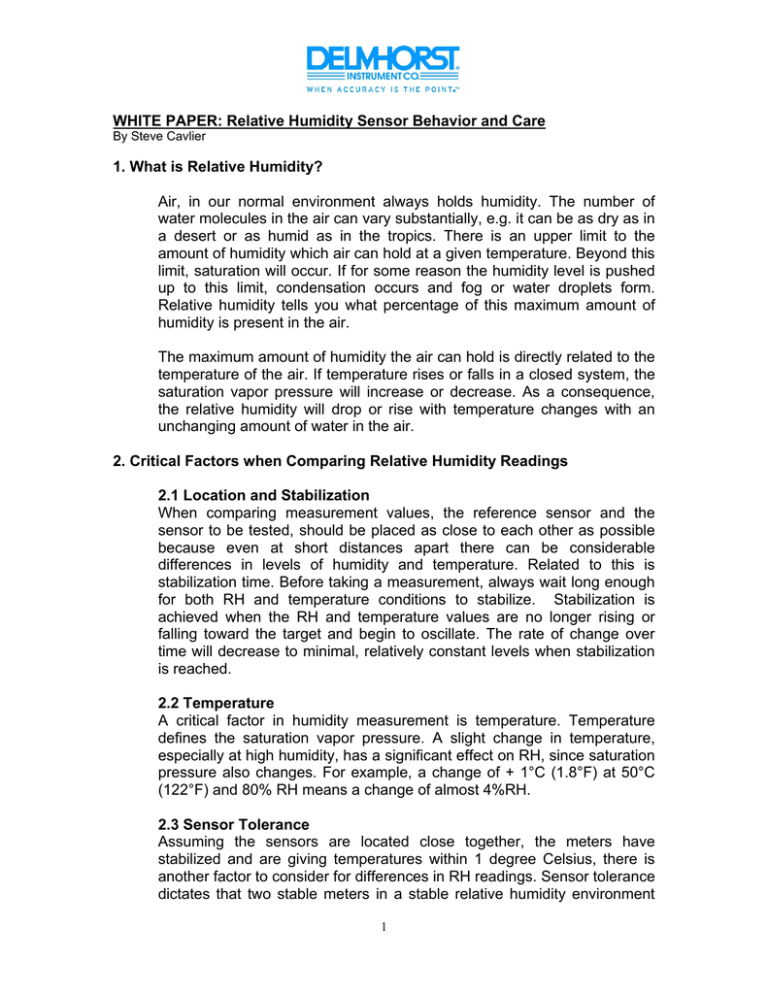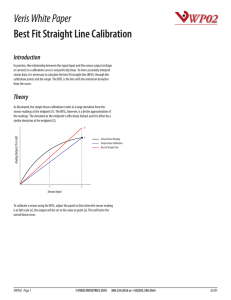WHITE PAPER: Relative Humidity Sensor Behavior and Care 1
advertisement

WHITE PAPER: Relative Humidity Sensor Behavior and Care By Steve Cavlier 1. What is Relative Humidity? Air, in our normal environment always holds humidity. The number of water molecules in the air can vary substantially, e.g. it can be as dry as in a desert or as humid as in the tropics. There is an upper limit to the amount of humidity which air can hold at a given temperature. Beyond this limit, saturation will occur. If for some reason the humidity level is pushed up to this limit, condensation occurs and fog or water droplets form. Relative humidity tells you what percentage of this maximum amount of humidity is present in the air. The maximum amount of humidity the air can hold is directly related to the temperature of the air. If temperature rises or falls in a closed system, the saturation vapor pressure will increase or decrease. As a consequence, the relative humidity will drop or rise with temperature changes with an unchanging amount of water in the air. 2. Critical Factors when Comparing Relative Humidity Readings 2.1 Location and Stabilization When comparing measurement values, the reference sensor and the sensor to be tested, should be placed as close to each other as possible because even at short distances apart there can be considerable differences in levels of humidity and temperature. Related to this is stabilization time. Before taking a measurement, always wait long enough for both RH and temperature conditions to stabilize. Stabilization is achieved when the RH and temperature values are no longer rising or falling toward the target and begin to oscillate. The rate of change over time will decrease to minimal, relatively constant levels when stabilization is reached. 2.2 Temperature A critical factor in humidity measurement is temperature. Temperature defines the saturation vapor pressure. A slight change in temperature, especially at high humidity, has a significant effect on RH, since saturation pressure also changes. For example, a change of + 1°C (1.8°F) at 50°C (122°F) and 80% RH means a change of almost 4%RH. 2.3 Sensor Tolerance Assuming the sensors are located close together, the meters have stabilized and are giving temperatures within 1 degree Celsius, there is another factor to consider for differences in RH readings. Sensor tolerance dictates that two stable meters in a stable relative humidity environment 1 may still read up to several percent RH apart. For example, a particular sensor may have a tolerance of +/-3% RH. That means two meters measuring in an environment with an actual RH of 50% may read anywhere in between 47% to 53% RH. These meters are considered to be in calibration even though they may read up to 6% apart. This is an allowable error assuming the other factors such as temperature differences and/or stabilization related differences are accounted for. 3. Response Time 3.1 Overview Response time is often quoted by manufacturers in the form of X seconds to get to 90% of the final relative humidity value. For example, if the RH is actually 80% and the manufacturer claims that the sensor will reach 90% of the final value in 45 seconds, that means the meter will read at least 72% RH (assuming it’s rising) after 45 seconds. That is still 8% RH away from the final value. It may indeed take 1-5 minutes to go the rest of the way to 80% depending on the many variables that go into relative humidity measurements. The response time will vary greatly in moving air vs. static air environments. It will vary depending on the sensor’s age, level of contamination, and the chemicals or vapors present in the environment in which it is being used. 3.2 How Calibration May Effect Response Time Differences in calibration, or meters that may be out of calibration may appear to respond slowly, even though that may not be the case. Take the same example as above, where the actual RH is 80%. However, the meter is - 5% out of calibration. It will never reach 80% because it interprets actual as 75%. So after 45 seconds it reads only 67.5% RH. To the observer it appears as though the response time is slower. The response time is not slower in this case; it’s just further away from the expected results after 45 seconds because the meter is out of calibration. This is very important when comparing two meters. Although one may appear slower than the other, it is only because they are ending at different points. Even two meters in calibration may have an endpoint up to 4% or 6% apart (+/2% and +/-3% tolerance). 4. Why Relative Humidity Sensors Fall out of Calibration 4.1 Exposure to Harmful Chemicals or Materials Chemical vapors and out-gasing of materials are known to interfere with the polymer layers used for capacitive humidity sensors. The diffusion of 2 chemicals into the polymer may cause a shift in both offset and sensitivity. In a clean environment the contaminants will slowly outgas, ie; contaminants leave the sensor and it returns to a normal state. However, high levels of pollutants may cause permanent damage to the sensing polymer. Some materials known to be harmful to the sensor include plastics such as delrin, acetate, PVC, polystyrene, adhesive tapes and adhesives other than silicone or epoxy. Exposure to these materials should be avoided. In extreme cases, exposure to some of these harmful chemicals or materials can harm the sensor in just a few hours or less. The sensor should never be left in a plastic carrying case, tool box, or work site outside of its original packaging. Rapid degradation of calibration could occur from enclosed close proximity of harmful materials. 4.2 Sensor Aging A second source of error is RH sensor aging. As the sensor is constantly exposed to moist air, contaminant particles are slowly deposited on the sensor material, changing its properties and response time. This process will result in a reading drift over time. Some drift may also be generated by impurities that are deposited on the PC board as well potentially causing stray capacitance. These deviations may require periodic meter recalibration in demanding or higher precision applications. 4.3 How Long Will Sensor Calibration Last? Due to there being several causes for relative humidity sensors to drift and/or fall out of calibration, there is no definitive answer to this question. RH sensors vary significantly as to how long their calibrations may last. The length of time may range from just a few months to one year or more depending on how the sensor (and meter) is stored and the environment in which it is used. One user may find calibration still in tolerance after a year or more, while another may find drift after only a few months. It is inevitable however, that at one point or another all sensors will lose calibration. All relative humidity sensors must be recalibrated or replaced periodically. 5. Operating and Storage Conditions 5.1 Extreme Conditions: Conditions outside the recommended range of -20C to 60C (-4F to 140F) and 20% to 60% RH may temporarily offset the RH signal. After returning 3 to normal conditions it will slowly return towards calibration state by itself. It is recommended the meter/sensor is not stored outside of these conditions. 5.2 Membrane or Protective Covering A membrane or protective covering may be used to prevent dirt or chemicals from entering the housing and protect the sensor. It will reduce peak concentrations of chemical vapors and extend calibration life. 5.3 Regular Storage It is recommended the sensor be exposed to as little air as possible when not in use to help prevent contamination resulting from normal sensor aging. Always store the sensor in original packaging, and/or use a protective covering over the sensor housing if possible when not in use. 5.4 Handling The sensing element is very sensitive and easily contaminated. It should not be handled. This includes: a.) b.) c.) d.) Touching Washing Blowing with compressed air Coming in direct contact with any other material. 6. Calibration 6.1 Factory Calibration and Testing: Delmhorst adheres to nationally recognized standards and practices and uses the most accurate equipment available. Each sensor’s calibration is NIST (National Institute of Standards and Technology) traceable and checked against a chilled mirror hygrometer. 6.2 In-Field Calibration Check: In-Field calibration checks can be done by comparison against a second reference sensor or using saturated salt solutions. 6.2.1 Reference Sensor It is critical that a sensor designated as a ‘reference’ sensor be kept in its original packaging and stored in a clean, dry place whenever it is not being used for testing. This will ensure the reference sensor’s calibration remains in good-standing for as long as possible. 6.2.2 Saturated Salt Solutions When using saturated salt solutions, keep in mind the following: 4 a) It is generally accepted that a sensor should be left in a salt solution bottle for minimum 12 hours in order to reach the intended RH level. It is possible to reach stabilization for lower values in as little as 6-8 hours, depending on the RH level being generated, ambient conditions, container volume, and time elapsed while inserting the sensor. b) Prolonged exposure to high humidity, such as a 75.5% salt solution, can cause temporary or even permanent offset to the sensor. Care should be taken to limit the time exposed to such conditions to the minimum time required for testing. Recommendation is time should not exceed 24 hours. c) Temperature stability is critical to obtaining accurate readings from a saturated salt solution. Even with extreme care, some oscillation in temperature (and in turn RH%) can be expected. For example, a change of 0.1 degree Celsius can cause an RH difference of nearly 0.5% at the 75.5% levels. February 2012 5



